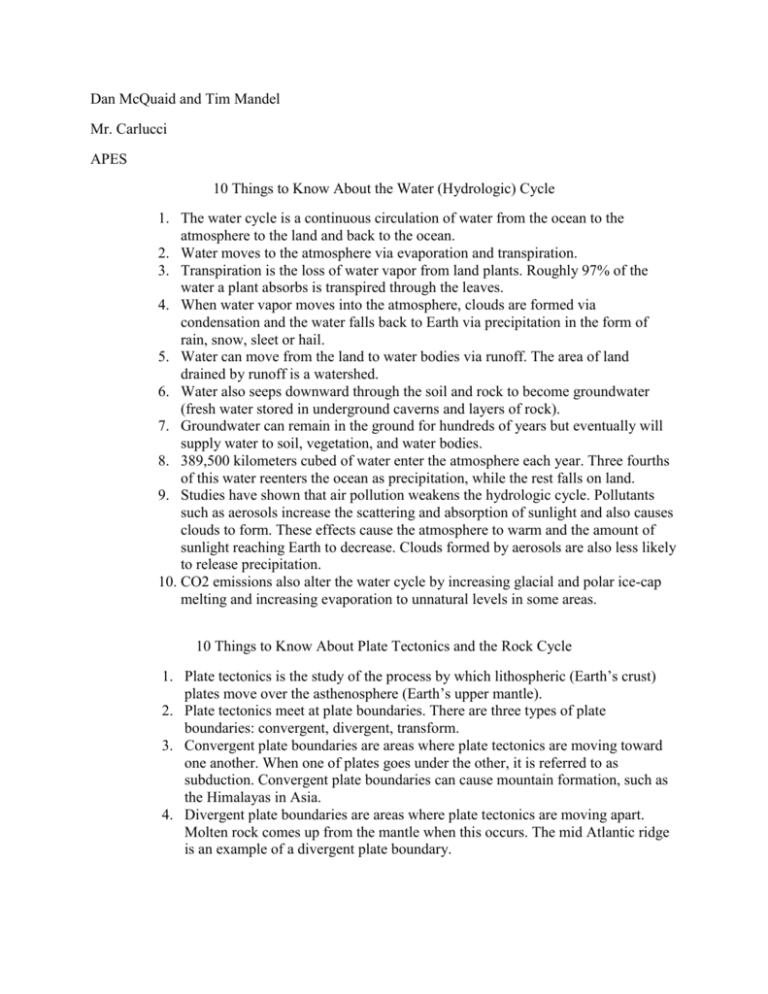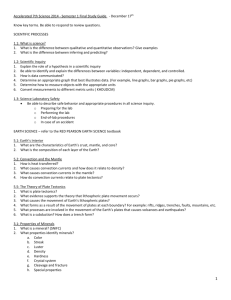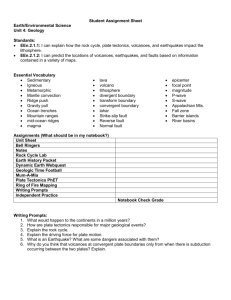Plate Tectonics, the Water Cycle, & Enviromental Disasters
advertisement

Dan McQuaid and Tim Mandel Mr. Carlucci APES 10 Things to Know About the Water (Hydrologic) Cycle 1. The water cycle is a continuous circulation of water from the ocean to the atmosphere to the land and back to the ocean. 2. Water moves to the atmosphere via evaporation and transpiration. 3. Transpiration is the loss of water vapor from land plants. Roughly 97% of the water a plant absorbs is transpired through the leaves. 4. When water vapor moves into the atmosphere, clouds are formed via condensation and the water falls back to Earth via precipitation in the form of rain, snow, sleet or hail. 5. Water can move from the land to water bodies via runoff. The area of land drained by runoff is a watershed. 6. Water also seeps downward through the soil and rock to become groundwater (fresh water stored in underground caverns and layers of rock). 7. Groundwater can remain in the ground for hundreds of years but eventually will supply water to soil, vegetation, and water bodies. 8. 389,500 kilometers cubed of water enter the atmosphere each year. Three fourths of this water reenters the ocean as precipitation, while the rest falls on land. 9. Studies have shown that air pollution weakens the hydrologic cycle. Pollutants such as aerosols increase the scattering and absorption of sunlight and also causes clouds to form. These effects cause the atmosphere to warm and the amount of sunlight reaching Earth to decrease. Clouds formed by aerosols are also less likely to release precipitation. 10. CO2 emissions also alter the water cycle by increasing glacial and polar ice-cap melting and increasing evaporation to unnatural levels in some areas. 10 Things to Know About Plate Tectonics and the Rock Cycle 1. Plate tectonics is the study of the process by which lithospheric (Earth’s crust) plates move over the asthenosphere (Earth’s upper mantle). 2. Plate tectonics meet at plate boundaries. There are three types of plate boundaries: convergent, divergent, transform. 3. Convergent plate boundaries are areas where plate tectonics are moving toward one another. When one of plates goes under the other, it is referred to as subduction. Convergent plate boundaries can cause mountain formation, such as the Himalayas in Asia. 4. Divergent plate boundaries are areas where plate tectonics are moving apart. Molten rock comes up from the mantle when this occurs. The mid Atlantic ridge is an example of a divergent plate boundary. 5. Transform plate boundaries are areas where plate tectonics move horizontally in opposite but parallel directions. A fault line is where transform plate boundaries meet. The San Andreas Fault in California is a famous transform plate boundary. 6. Earthquakes and volcanoes are frequently found at plate boundaries. For instance, earthquakes frequently occur in California due to the activity of the San Andreas fault. 7. Rocks are aggregates of minerals (naturally occurring inorganic solids). There are three types of rocks: igneous, sedimentary, and metamorphic. The rock cycle is a cycle of transformation between these three rock types. 8. Igneous rocks form when magma rises from the mantle, cools and solidifies. Sedimentary rocks form when small fragments of weathered rocks are compacted. Metamorphic rocks form when intense heat and pressure are applied to a rock. 9. The rock cycle continually modifies, transports and destroys rocks. For instance, igneous rocks are uplifted to the surface from the mantle and are weathered down to sediments, which morph into sedimentary rock. Sedimentary rock is then heated and under intense pressure, turning into metamorphic rock. Metamorphic rock then melts, cools and solidifies into igneous rock, and the cycle repeats. 10. An ore is a rock that can be extracted for a particular mineral. Minerals are metallic or nonmetallic. Metals are malleable, lustrous and good conductors of heat and electricity. Nonmetals lack these characteristics. 10 Things to Know about Environmental Disasters 1. Environmental disasters are environmental changes induced by human activity. They are different from natural disasters, which are caused by natural changes in the environment. 2. Environmental disasters can have an effect on agriculture, biodiversity, the economy and human health. The causes include pollution, depletion of natural resources, industrial activity or agriculture. 3. The Union Carbide gas leak of 1984 is one of the most famous environmental disasters. On December 3rd, shortly after midnight, a poisonous gas cloud escaped from the Union Carbide India Limited (UCIL) pesticide factory. The gas leak killed at least 4.000 local residents instantly and caused health problems for at least 50,000 to perhaps 500,000 people. These health problems killed around 15,000 more victims in the years that followed. Approximately 100,000 people still suffer from chronic disease consequential to gas exposure today. 4. The Chernobyl disaster of 1986 was one of the worst nuclear environmental disasters in the world. Due to technical malfunctions temperatures reached more than 2000 °C, causing fuel rod melting. Extreme pressures in cooling water pipes opened up cracks, which released steam and caused an explosion. Approximately 200 billion curies of radioactive material was released. Hundreds of thousands of people have been affected by the radiation of this disaster, and many are still being treated for it. 5. The Seveso explosion of 1976 released a toxic cloud into the atmosphere containing high concentrations of TCDD, a highly toxic form of dioxin. Downwind of the explosion the dioxin cloud killed many animals immediately and impacted 11 communities surrounding the factory. 6. The heaviest winter smog episode known to man occurred in London from December 1952 to March 1953. Light winds and a high moisture content created ideal conditions for smog formation. Additional coal combustion from an influx of cars also created the smog problem. Visibility dropped to only a few meters and over 12,000 people were killed from the smog episode. 7. Several important oil spills have had detrimental environmental impacts. For example, the Exxon Valdez Spill of 1989 polluted 190km of Alaskan coastline. The oil spill killed approximately 250,000 sea birds, 2,800 sea otters, 250 bald eagles and 22 killer whales. 8. The Love Canal is a neighborhood in Niagra Falls that fell victim to chemical wastes of the Hooker Chemical factory that was in the area before the neighborhood developed. Families in the neighborhood experienced illness, miscarriages and birth defects due to chemical poisoning. When the Love Canal was searched over 20,000 pounds of wastes were found in the previous landfill. 9. On January 30, 2000 cyanide used in a gold mine in Baia Mare overflowed into the major river the Somes and subsequently into the river Tisza in Romania. At least 100,000 cubic meters of water were highly contaminated with cyanide as a result. The spill killed many aquatic animals and plants as well as people in the surrounding area. 10. Mad cow disease is caused by feeding cows with meat and a high protein substance called bone meal. It was discovered in 1986 that feeding cows with this substance was becoming increasingly more common. This harmed both cows and humans across Europe and the world. 11. The Three Mile Island nuclear disaster of 1979 released 18 billion curies of radiation. Fortunately, no significant human harm came of it due to the containment of this radiation and the evacuation of people from the surrounding area. However, there were still some premature deaths and birth defects, even from those who evacuated.






